Correlation between Surface Integrity and Low Cycle Fatigue Life of Machined Inconel 718
Abstract
1. Introduction
2. Experiments
2.1. Materials
2.2. Experimental Method and Process
3. Micro–Macro FEM LCF Life Prediction Model for Inconel 718
4. Result and discussion
5. Conclusions
Author Contributions
Funding
Data Availability Statement
Conflicts of Interest
References
- Vayssette, B.; Saintier, N.; Brugger, C.; Mohamed, E. Surface roughness effect of SLM and EBM Ti-6Al-4V on multiaxial high cycle fatigue. Theor. Appl. Fract. Mec. 2020, 108, 102581. [Google Scholar] [CrossRef]
- Javadi, H.; Jomaa, W.; Songmene, V.; Brochu, M.; Bocher, P. Inconel 718 superalloy controlled surface integrity for fatigue applications produced by precision turning. Int. J. Precis. Eng. Man. 2019, 20, 1297–1310. [Google Scholar] [CrossRef]
- Javadi, H.; Jomaa, W.; Dalgaard, E.; Brochu, M.; Bocher, P. Influence of surface residual stresses on the fatigue life and crack propagation behavior of turned Inconel 718 super-alloy. In MATEC Web of Conferences; EDP Sciences: Les Ulis, France, 2018; Volume 165, p. 18004. [Google Scholar]
- Gao, Y.; Yang, W.; Huang, Z.; Lu, Z. Effects of residual stress and surface roughness on the fatigue life of nickel aluminium bronze alloy under laser shock peening. Eng. Fract. Mech. 2021, 244, 107524. [Google Scholar] [CrossRef]
- Seemikeri, C.Y.; Brahmankar, P.K.; Mahagaonkar, S.B. Improvements in surface integrity and fatigue life of low plasticity burnished surfaces. Int. J. Microstruct. Mater. Prop. 2012, 7, 27–48. [Google Scholar] [CrossRef]
- Ren, X.; Liu, Z.; Liang, X.; Cui, P. Effects of machined surface integrity on high-temperature low-cycle fatigue life and process parameters optimization of turning superalloy Inconel 718. Materials 2021, 14, 2428. [Google Scholar] [CrossRef] [PubMed]
- Madariaga, A.; Garay, A.; Esnaola, J.A.; Arrazola, P.J.; Linaza, A. Effect of surface integrity generated by machining on isothermal low cycle fatigue performance of Inconel 718. Eng. Failure Anal. 2022, 137, 106422. [Google Scholar] [CrossRef]
- Suraratchai, M.; Limido, J.; Mabru, C.; Chieragatti, R. Modelling the influence of machined surface roughness on the fatigue life of aluminium alloy. Int. J. Fatigue 2008, 30, 2119–2126. [Google Scholar] [CrossRef]
- Wu, Z.; Wang, S.; Yang, X.; Pan, L.; Song, Y. Fatigue life prediction for Ni-based superalloy GH4169 considering machined surface roughness and residual stress effects. J. Mec. Theor. Appl. 2021, 59, 215–226. [Google Scholar] [CrossRef]
- Yang, S.; Yang, L.; Wang, Y. Determining the fatigue parameters in total strain life equation of a material based on monotonic tensile mechanical properties. Eng. Fract. Mech. 2020, 226, 106866. [Google Scholar] [CrossRef]
- Li, L.; Zhang, Z.; Zhang, P.; Li, C.; Zhang, Z. Dislocation arrangements within slip bands during fatigue cracking. Mater. Charact. 2018, 145, 96–100. [Google Scholar] [CrossRef]
- He, C.; Wu, Y.; Peng, L.; Su, N.; Li, X.; Yang, K.; Liu, Y.; Yuan, S.; Tian, R. Cyclic deformation and correspondent crack initiation at low-stress amplitudes in Mg–Gd–Y–Zr alloy. Materials 2018, 11, 2429. [Google Scholar] [CrossRef] [PubMed]
- Jablonski, D.A. The effect of ceramic inclusions on the low cycle fatigue life of low carbon astroloy subjected to hot isostatic pressing. Mater. Sci. Eng. 1981, 48, 189–198. [Google Scholar] [CrossRef]
- Alexandre, F.; Deyber, S.; Pineau, A. Modelling the optimum grain size on the low cycle fatigue life of a Ni based superalloy in the presence of two possible crack initiation sites. Scr. Mater. 2004, 50, 25–30. [Google Scholar] [CrossRef]
- Guo, G.; Jiang, W.; Liu, X.; Chen, J.; Li, L.; Wang, J.; Zhang, Y.; Zhang, Z. In-situ SEM-EBSD investigation of the low-cycle fatigue deformation behavior of Inconel 718 at grain-scale. J. Mater. Res. Technol. 2023, 24, 5007–5023. [Google Scholar] [CrossRef]
- Tanaka, K.; Mura, T. A dislocation model for fatigue crack initiation. J. Appl. Mech. 1981, 1, 97–103. [Google Scholar] [CrossRef]
- Brucknerfoit, A.; Huang, X. Numerical simulation of micro-crack initiation of martensitic steel under fatigue loading. Int. J. Fatigue 2006, 28, 963–971. [Google Scholar] [CrossRef]
- Rahim, M.R.A.; Schmauder, S.; Manurung, Y.H.P.; Binkele, P.; Ahmad, M.I.M.; Dogahe, K. Cycle number estimation method on fatigue crack initiation using Voronoi tessellation and the Tanaka Mura model. J. Fail anal. Prev. 2023, 23, 548–555. [Google Scholar] [CrossRef]
- Zhou, J.; Barrett, R.A.; Leen, S.B. A physically-based method for predicting high temperature fatigue crack initiation in P91 welded steel. Int. J. Fatigue 2021, 153, 106480. [Google Scholar] [CrossRef]
- Kramberger, J.; Jezernik, N.; Göncz, P.; Glodež, S. Extension of the Tanaka–Mura model for fatigue crack initiation in thermally cut martensitic steels. Eng. Fract. Mech. 2010, 77, 2040–2050. [Google Scholar] [CrossRef]
- Wang, J.; Zhang, Y.; Liu, S.; Sun, Q.; Lu, H. Competitive giga-fatigue life analysis owing to surface defect and internal inclusion for FV520B-I. Int. J. Fatigue 2016, 87, 203–209. [Google Scholar] [CrossRef]
- Kang, G.; Luo, H. Review on fatigue life prediction models of welded joint. Acta Mech. Sin. 2020, 36, 701–726. [Google Scholar] [CrossRef]
- Singh, I.V.; Mishra, B.K.; Bhattacharya, S.; Patil, R.U. The numerical simulation of fatigue crack growth using extended finite element method. Int. J. Fatigue 2012, 36, 109–119. [Google Scholar] [CrossRef]
- Moës, N.; Dolbow, J.; Belytschko, T. A finite element method for crack growth without remeshing. Int. J. Numer. Meth. Eng. 1999, 46, 131–150. [Google Scholar] [CrossRef]
- Nikishkov, G.P.; Park, J.H.; Atluri, S.N. SGBEM-FEM alternating method for analyzing 3D non-planar cracks and their growth in structural components. Cmes-comp. Model. Eng. 2001, 2, 401–422. [Google Scholar]
- Chopp, D.L.; Sukumar, N. Fatigue crack propagation of multiple coplanar cracks with the coupled extended finite element/fast marching method. Int. J. Eng. Sci. 2003, 41, 845–869. [Google Scholar] [CrossRef]
- Bergara, A.; Dorado, J.I.; Martín-Meizoso, A.; Martínez-Esnaola, J.M. Fatigue crack propagation in complex stress fields: Experiments and numerical simulations using the extended finite element method (XFEM). Int. J. Fatigue 2017, 103, 112–121. [Google Scholar] [CrossRef]
- Naderi, M.; Iyyer, N. Fatigue life prediction of cracked attachment lugs using XFEM. Int. J. Fatigue 2015, 77, 186–193. [Google Scholar] [CrossRef]
- Chen, Z.; Bao, H.; Dai, Y.; Liu, Y. Numerical prediction based on XFEM for mixed-mode crack growth path and fatigue life under cyclic overload. Int. J. Fatigue 2022, 162, 106943. [Google Scholar] [CrossRef]
- Hua, Y.; Liu, Z. Experimental investigation of principal residual stress and fatigue performance for turned nickel-based superalloy Inconel 718. Appl. Sci. 2019, 9, 4750. [Google Scholar] [CrossRef]
- Deng, C.; Liu, G.; Gong, B.; Liu, Y. Fatigue crack initiation life prediction based on Tanaka-Mura dislocation model. Trans. China Weld. Inst. 2021, 42, 30–37. [Google Scholar]
- Zhao, Y.Y.; Nieh, T.G. Correlation between lattice distortion and friction stress in Ni-based equiatomic alloys. Intermetallics 2017, 86, 45–50. [Google Scholar] [CrossRef]
- Glodež, S.; Šori, M.; Kramberger, J. Prediction of micro-crack initiation in high strength steels using Weibull distribution. Eng. Fract. Mech. 2013, 108, 263–274. [Google Scholar] [CrossRef]
- Ou, C.; Voothaluru, R.; Liu, C.R. Fatigue crack initiation of metals fabricated by additive manufacturing—A crystal plasticity energy-based approach to IN718 life prediction. Crystals 2020, 10, 905. [Google Scholar] [CrossRef]
- Wang, X.; Huang, C.; Zou, B.; Liu, G.; Zhu, H.; Wang, J. Experimental study of surface integrity and fatigue life in the face milling of Inconel 718. Front. Mech. Eng. 2018, 13, 243–250. [Google Scholar] [CrossRef]
- Itoga, H.; Tokaji, K.; Nakajima, M.; Ko, H.N. Effect of surface roughness on step-wise s–n characteristics in high strength steel. Int. J. Fatigue 2003, 25, 379–385. [Google Scholar] [CrossRef]
- Arola, D.; Williams, C.L. Estimating the fatigue stress concentration factor of machined surfaces. Int. J. Fatigue 2002, 24, 923–930. [Google Scholar] [CrossRef]
- Yadollahi, A.; Mahmoudi, M.; Elwany, A.; Doude, H.; Bian, L.; Newman, J.C., Jr. Fatigue-life prediction of additively manufactured material: Effects of heat treatment and build orientation. Fatigue Fract. Eng. Mater. Struct. 2020, 43, 831–844. [Google Scholar] [CrossRef]
- Cai, W. Effect of Long-Term Aging on Microstructure Evolvement and Fatigue Crack Growth Behavior of GH4169 Alloy. Master’s Thesis, Northeastern University, Shenyang, China, 2015. [Google Scholar]
- Zhao, X.; Zhou, H.; Liu, Y. Effect of shot peening on the fatigue properties of nickel-based superalloy GH4169 at high temperature. Results Phys. 2018, 11, 452–460. [Google Scholar] [CrossRef]
- Hua, Y.; Liu, Z.; Wang, B.; Hou, X. Surface modification through combination of finish turning with low plasticity burnishing and its effect on fatigue performance for Inconel 718. Surf. Coat. Technol. 2019, 375, 508–517. [Google Scholar] [CrossRef]


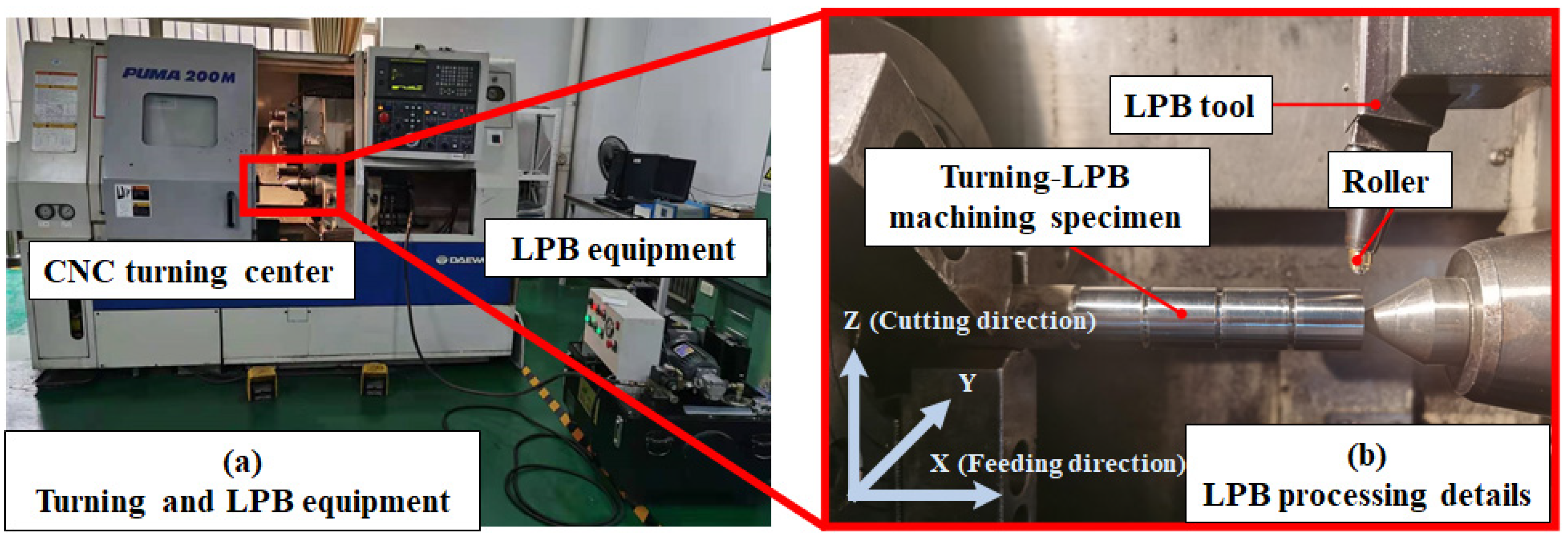
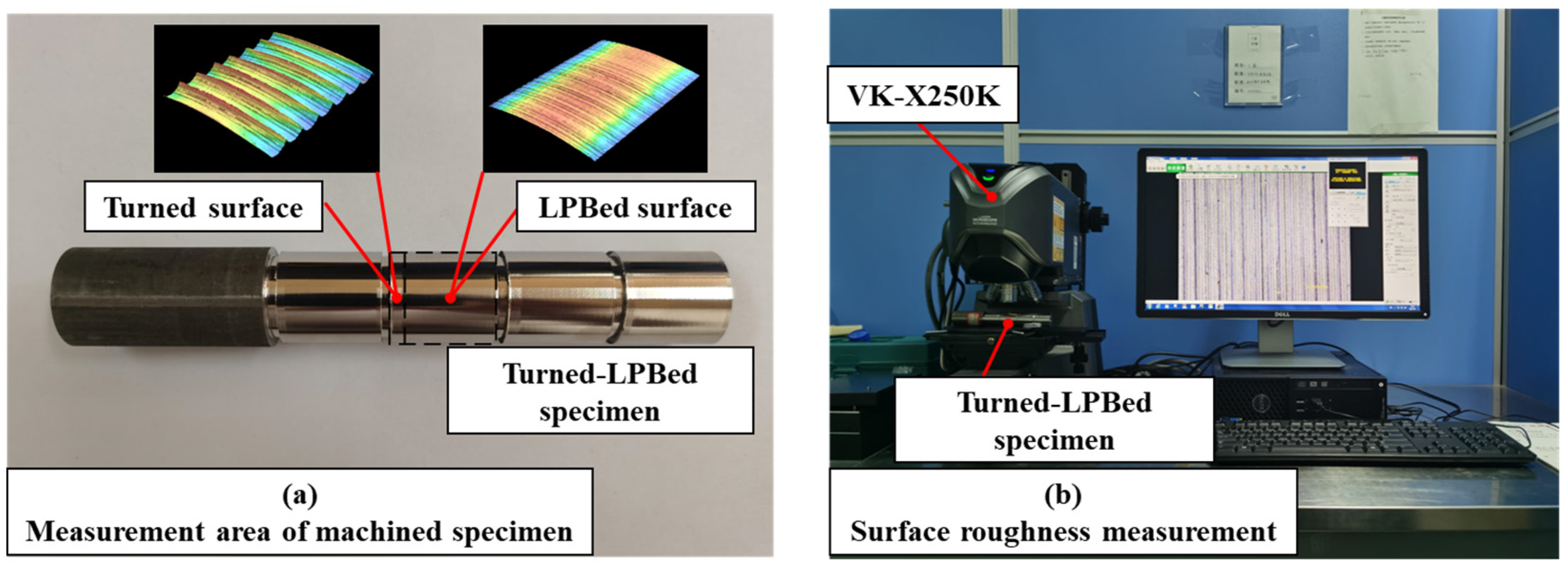

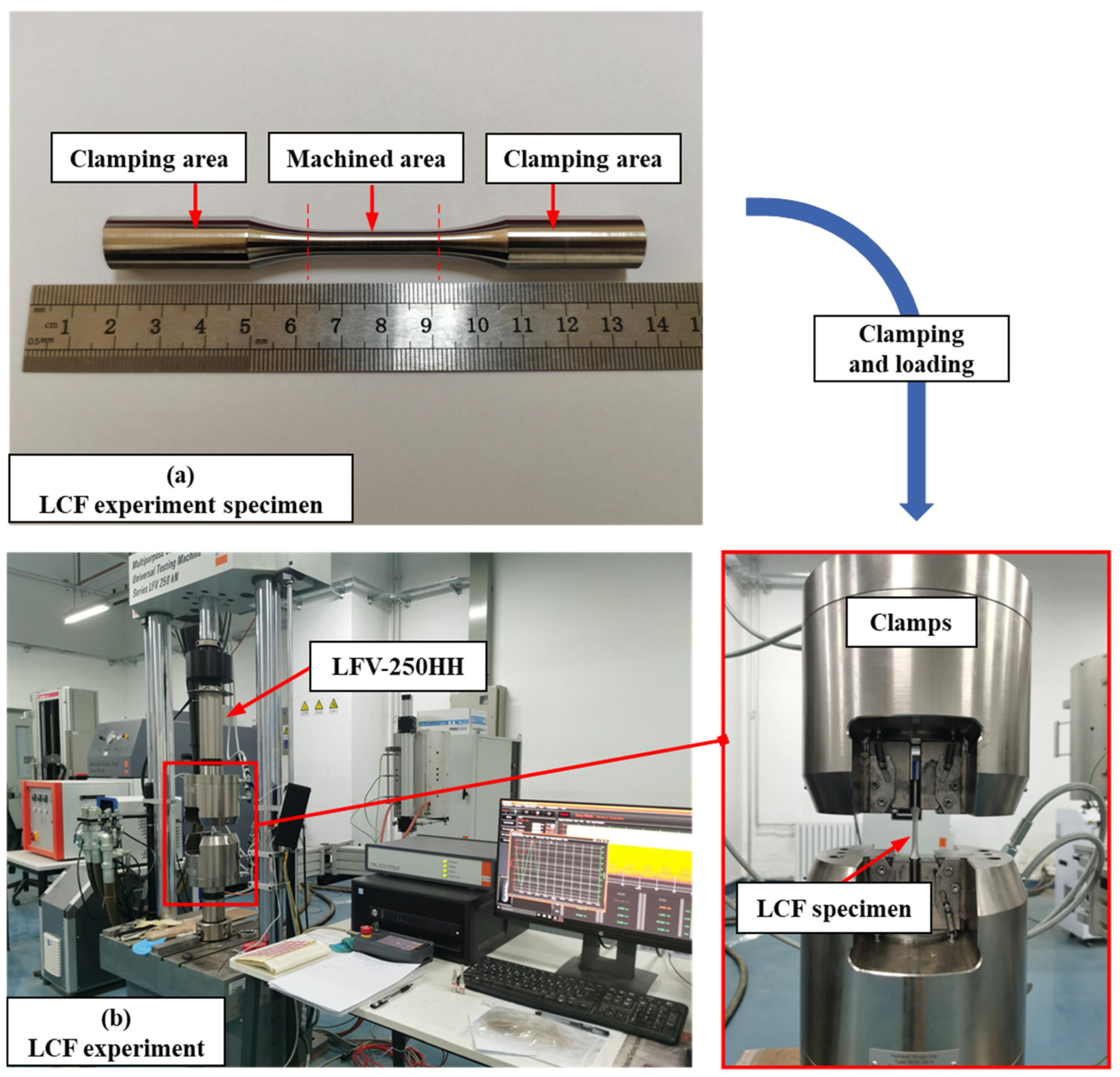

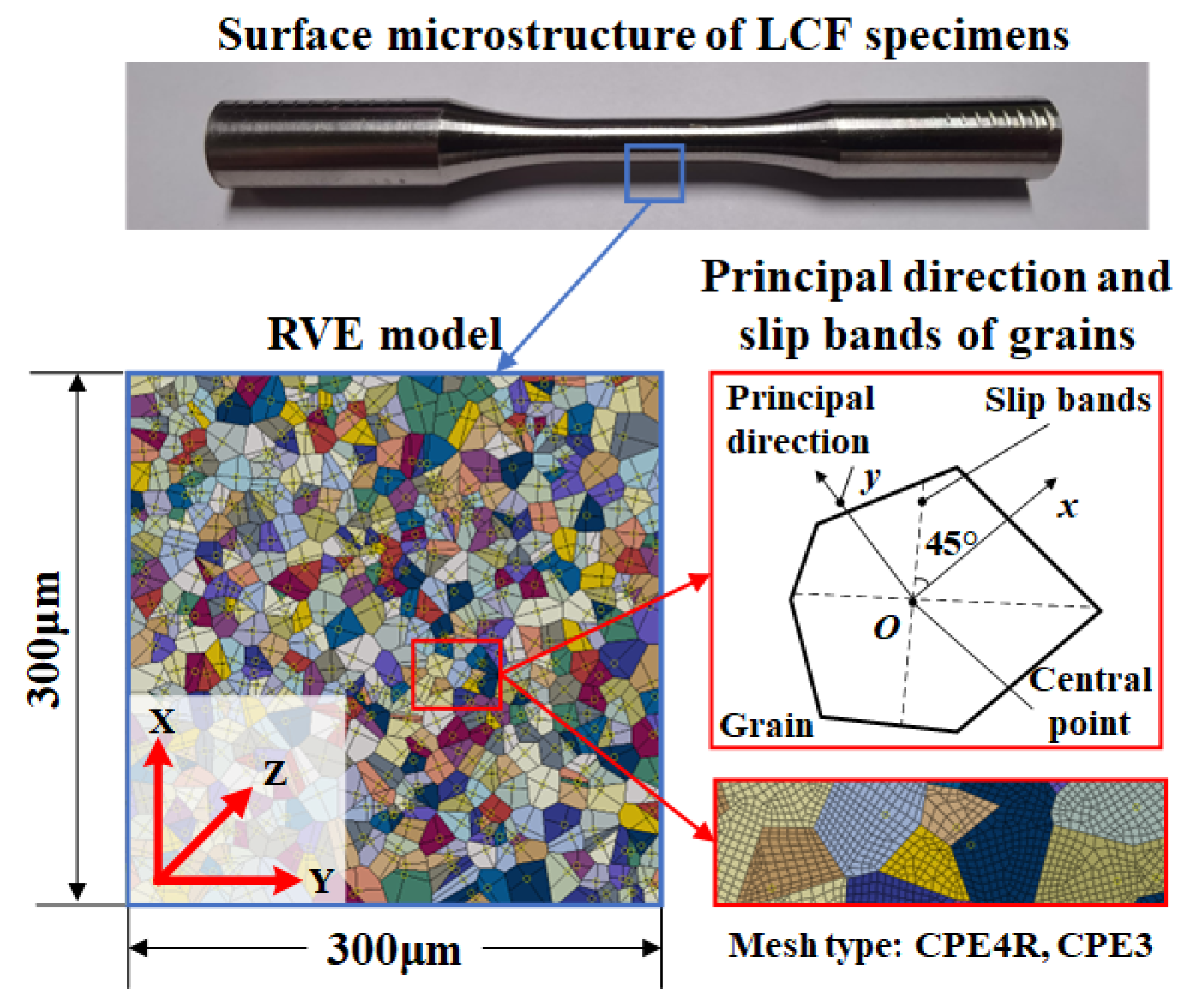
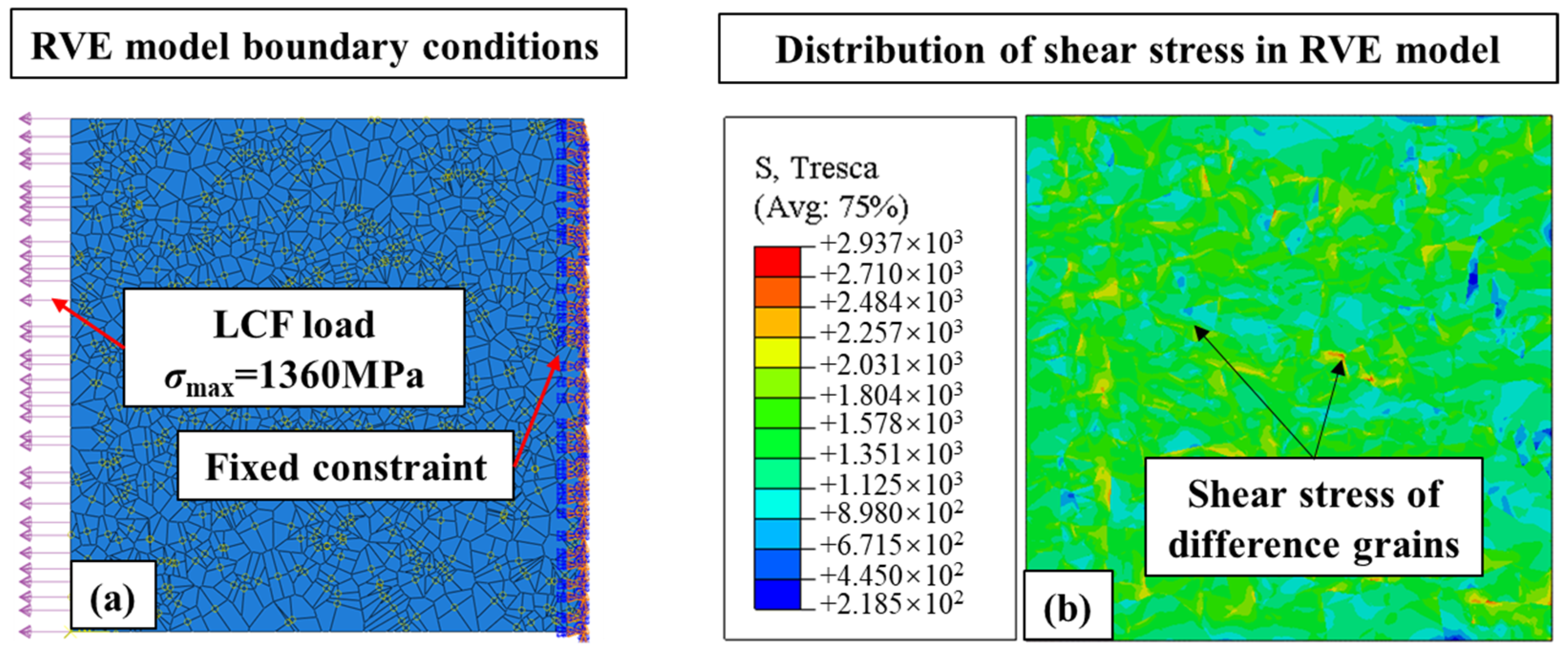
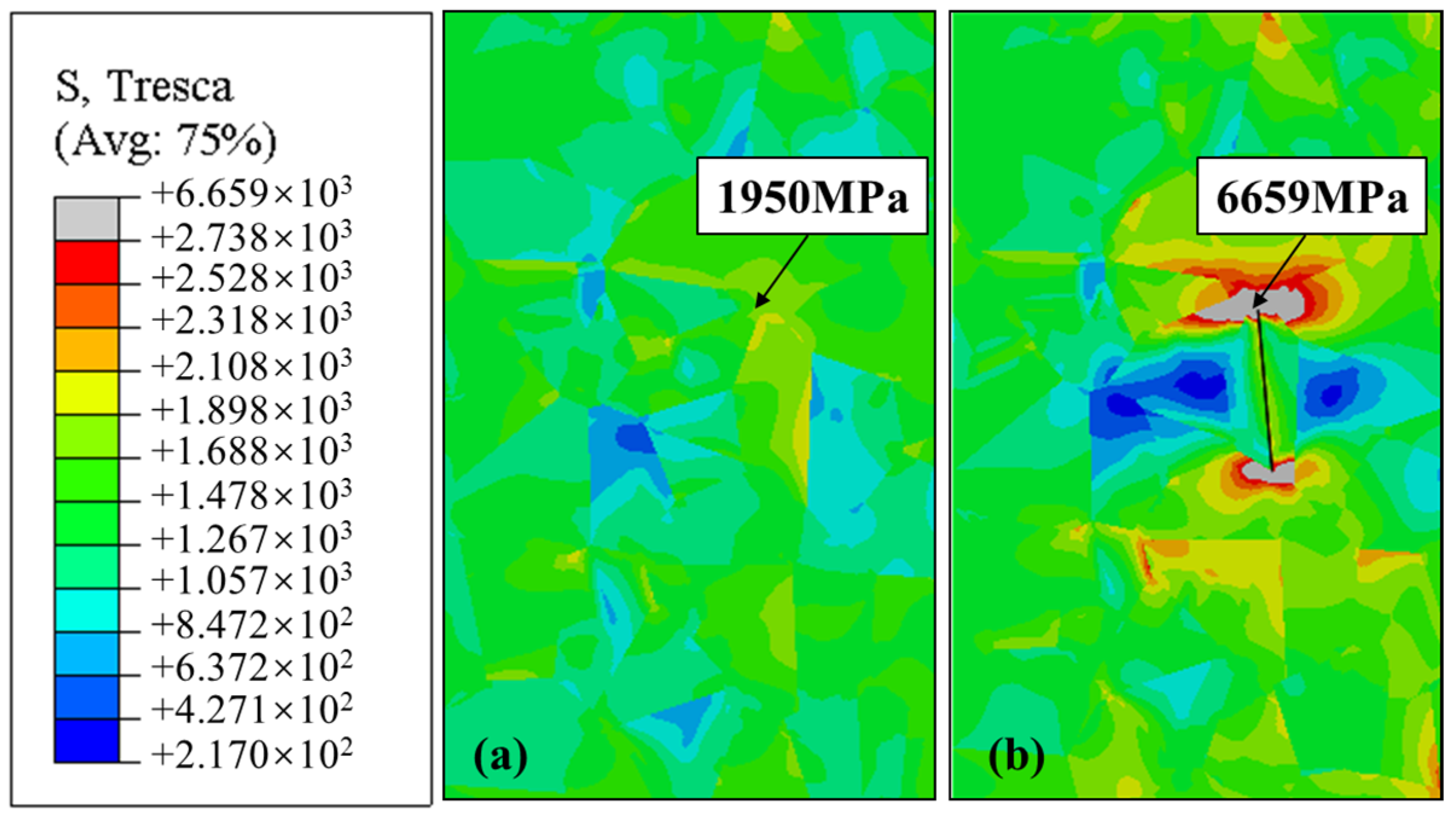
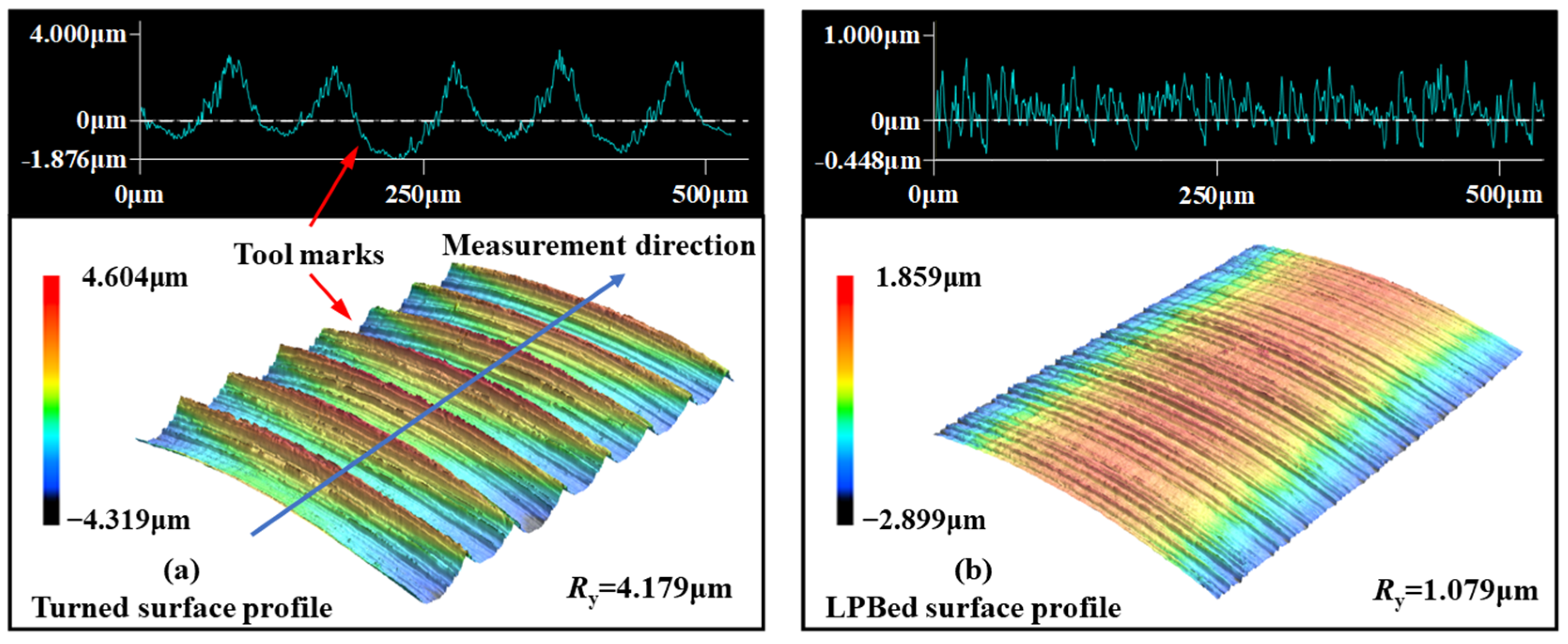


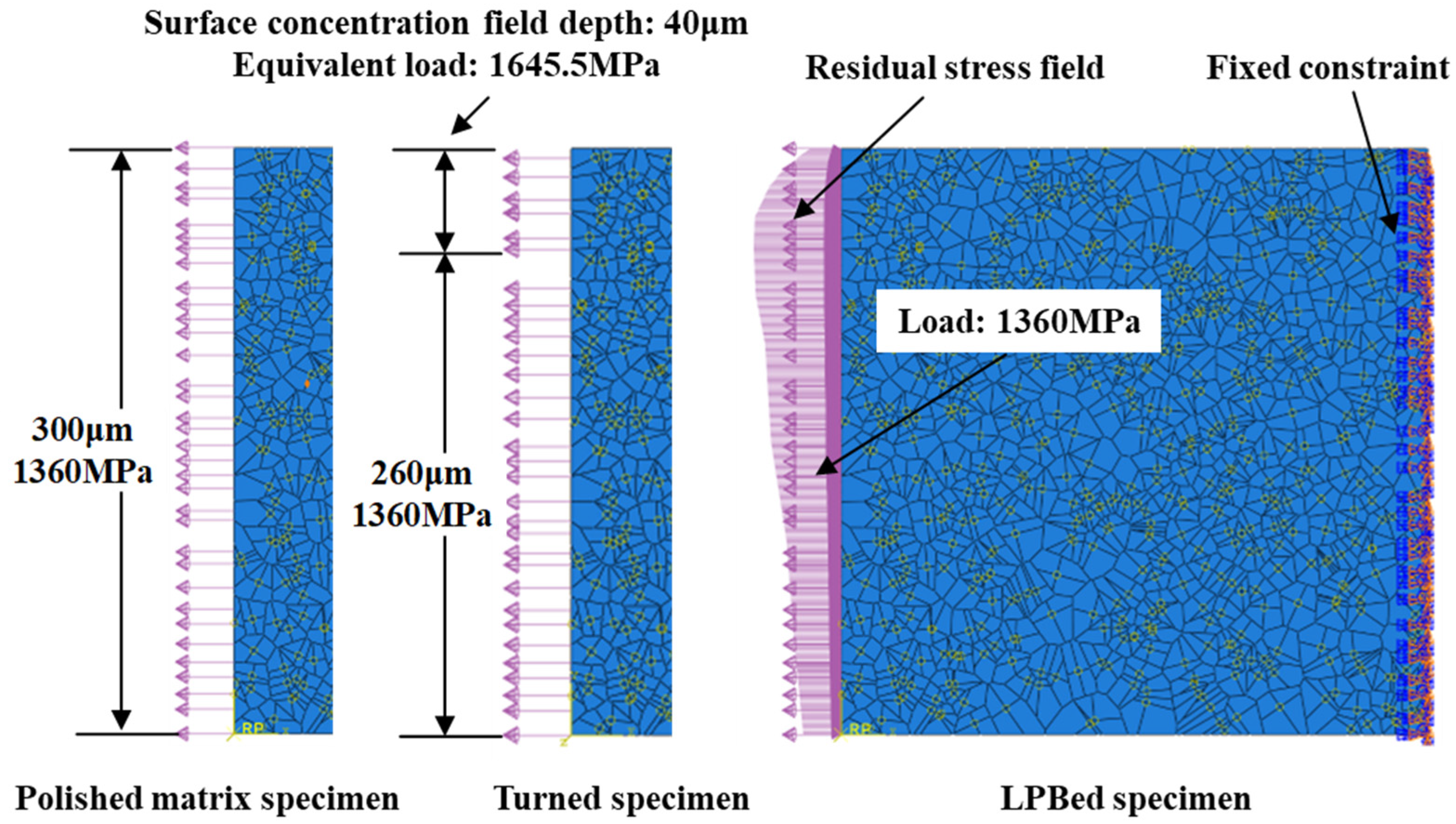
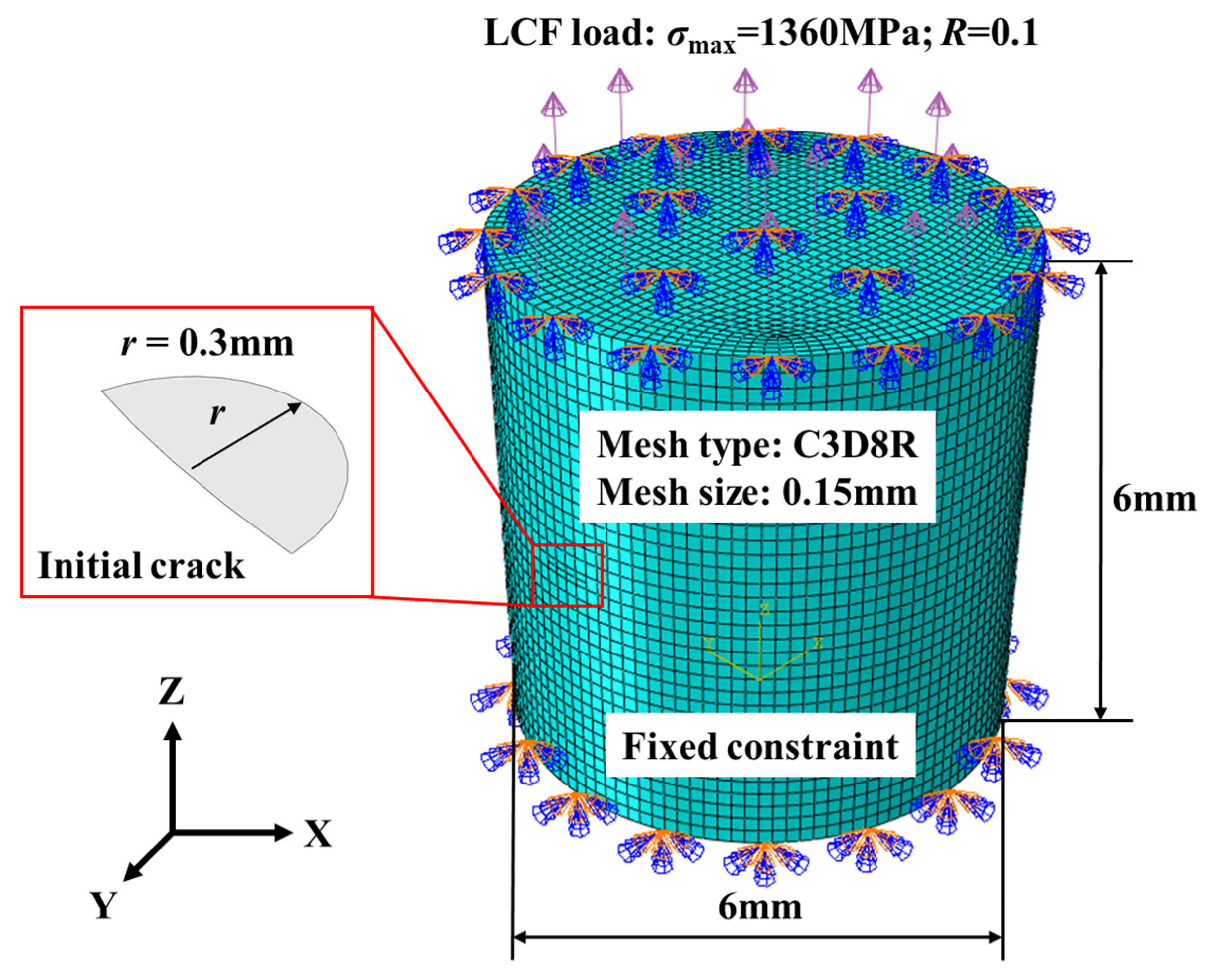
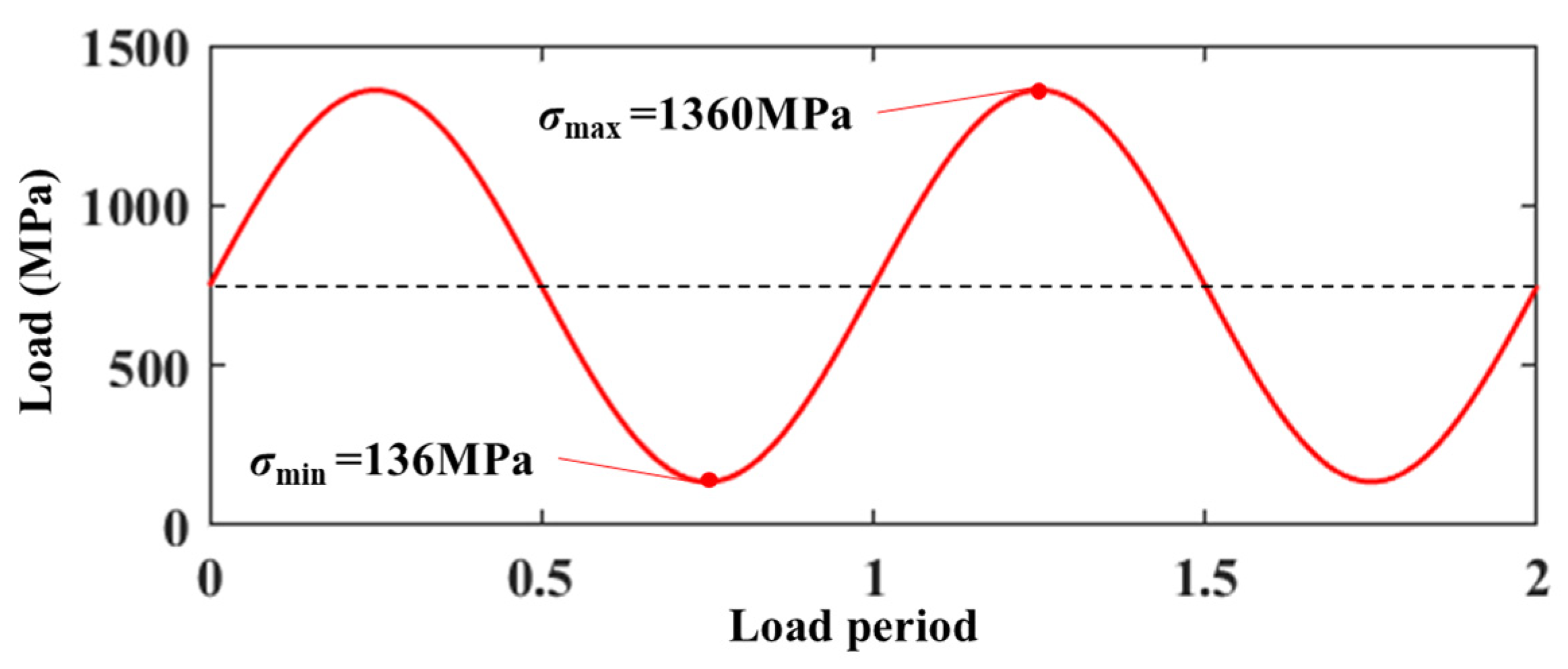


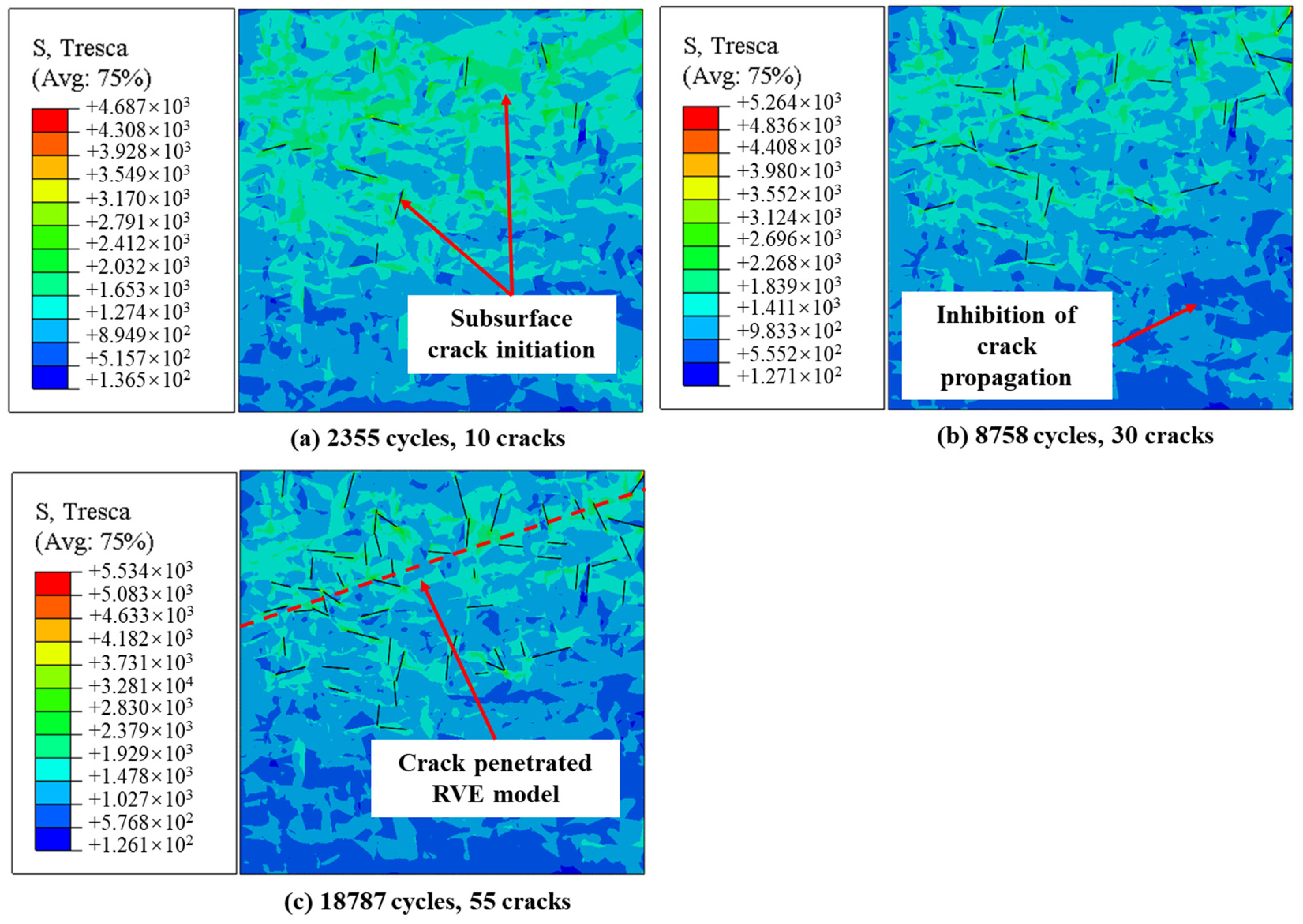

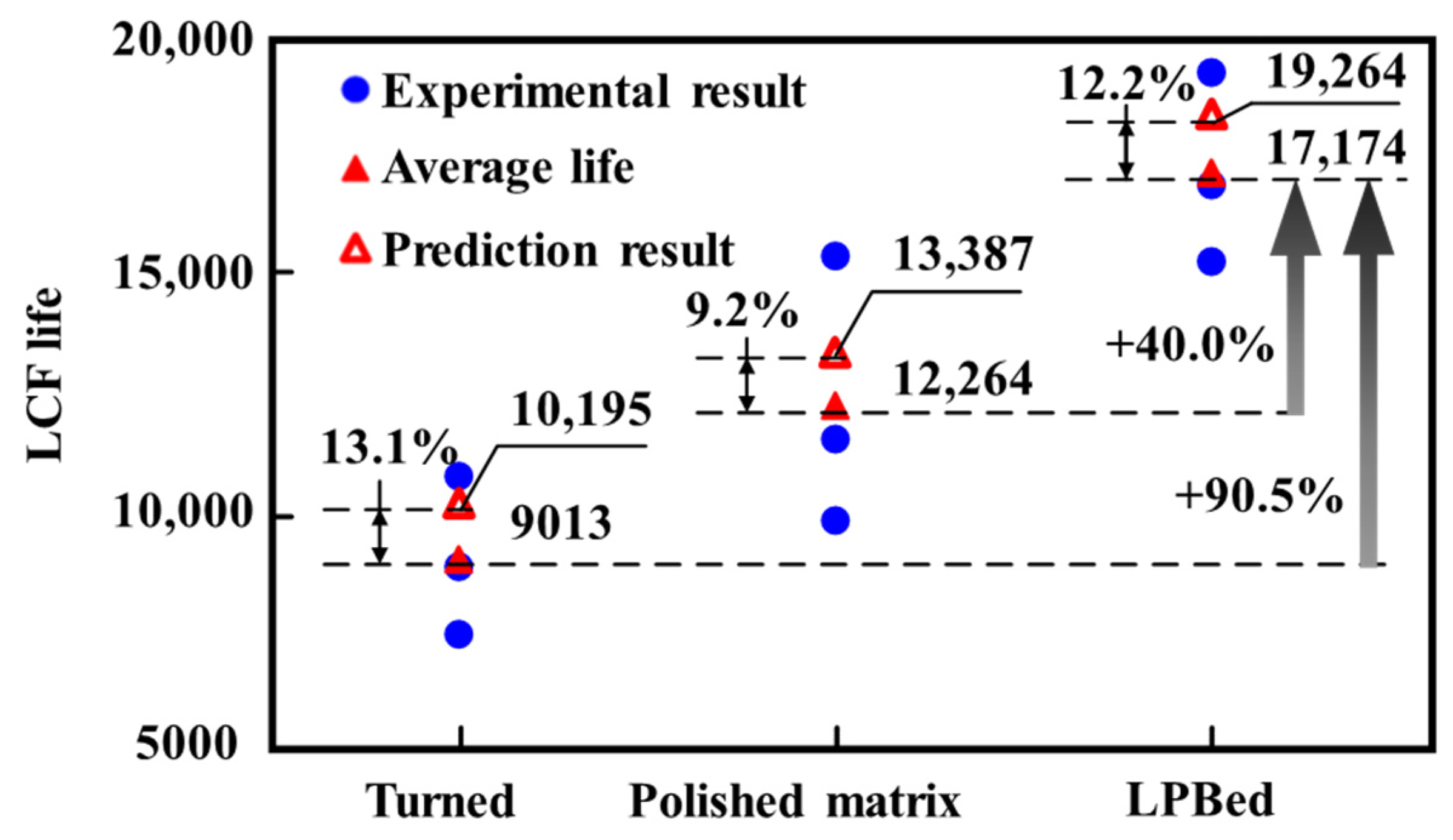
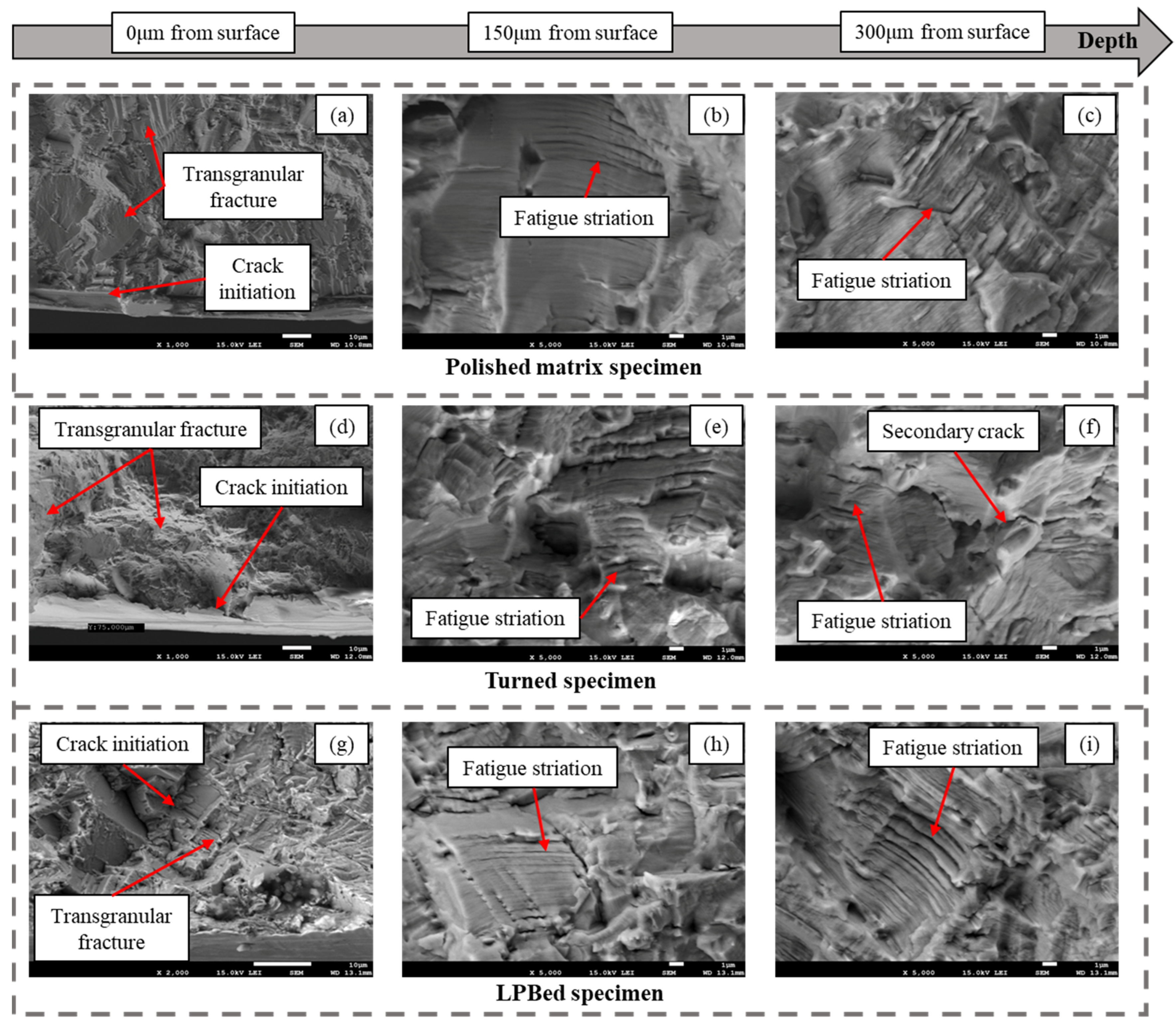
| Elastic Modulus | Yield Strength | Tensile Strength | Elongation | Hardness |
|---|---|---|---|---|
| E (GPa) | σs (MPa) | σb (MPa) | (%) | (HBW) |
| 205 | 1360.5 | 1502 | 19.3 | 439 |
| Material | G (MPa) | ν | K (MPa) | Ws (KJ·m–2) |
|---|---|---|---|---|
| Inconel 718 | 78,850 | 0.3 | 150 | 6.5 |
| C11 (GPa) | C22 (GPa) | C33 (GPa) | C12 (GPa) | C13 (GPa) | C23 (GPa) | C44 (GPa) | C55 (GPa) | C66 (GPa) |
|---|---|---|---|---|---|---|---|---|
| 230 | 230 | 230 | 170 | 170 | 170 | 100 | 100 | 100 |
| Ra (μm) | Ry (μm) | Rz (μm) | Ρ (mm) | Kt | dt (μm) |
|---|---|---|---|---|---|
| 0.942 | 4.179 | 5.078 | 3.179 | 1.72 | 40 |
| Material | G (GPa) | ν | Paris Model Parameters | |
|---|---|---|---|---|
| C | m | |||
| Inconel 718 | 210 | 0.3 | 1.13×10−11 | 2.74 |
Disclaimer/Publisher’s Note: The statements, opinions and data contained in all publications are solely those of the individual author(s) and contributor(s) and not of MDPI and/or the editor(s). MDPI and/or the editor(s) disclaim responsibility for any injury to people or property resulting from any ideas, methods, instructions or products referred to in the content. |
© 2024 by the authors. Licensee MDPI, Basel, Switzerland. This article is an open access article distributed under the terms and conditions of the Creative Commons Attribution (CC BY) license (https://creativecommons.org/licenses/by/4.0/).
Share and Cite
Cui, P.; Liu, Z.; Zhao, J.; Ren, X. Correlation between Surface Integrity and Low Cycle Fatigue Life of Machined Inconel 718. Metals 2024, 14, 178. https://doi.org/10.3390/met14020178
Cui P, Liu Z, Zhao J, Ren X. Correlation between Surface Integrity and Low Cycle Fatigue Life of Machined Inconel 718. Metals. 2024; 14(2):178. https://doi.org/10.3390/met14020178
Chicago/Turabian StyleCui, Pengcheng, Zhanqiang Liu, Jinfu Zhao, and Xiaoping Ren. 2024. "Correlation between Surface Integrity and Low Cycle Fatigue Life of Machined Inconel 718" Metals 14, no. 2: 178. https://doi.org/10.3390/met14020178
APA StyleCui, P., Liu, Z., Zhao, J., & Ren, X. (2024). Correlation between Surface Integrity and Low Cycle Fatigue Life of Machined Inconel 718. Metals, 14(2), 178. https://doi.org/10.3390/met14020178








